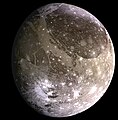Файл:The Galilean satellites (the four largest moons of Jupiter).tif

Размер этого JPG-превью для исходного TIF-файла: 800 × 262 пкс. Другие разрешения: 320 × 105 пкс | 640 × 210 пкс.
Исходный файл (1830 × 600 пкс, размер файла: 1,51 МБ, MIME-тип: image/tiff)
История файла
Нажмите на дату/время, чтобы посмотреть файл, который был загружен в тот момент.
| Дата/время | Миниатюра | Размеры | Участник | Примечание | |
|---|---|---|---|---|---|
| текущий | 12:54, 29 декабря 2011 | 1830 × 600 (1,51 МБ) | Prof. Professorson | {{Information |Description=This composite includes the four largest moons of en:Jupiter which are known as the Galilean satellites. The Galilean satellites were first seen by the Italian astronomer en:Galileo Galilei in |
Использование файла
Следующие 3 страницы используют этот файл:
Глобальное использование файла
Данный файл используется в следующих вики:
- Использование в af.wikipedia.org
- Использование в als.wikipedia.org
- Использование в ar.wikipedia.org
- Использование в ast.wikipedia.org
- Использование в az.wikipedia.org
- Использование в ba.wikibooks.org
- Использование в be-tarask.wikipedia.org
- Использование в be.wikipedia.org
- Использование в bg.wikipedia.org
- Использование в bn.wikipedia.org
- Использование в bn.wikibooks.org
- Использование в bs.wikibooks.org
- Использование в ca.wikipedia.org
- Использование в cs.wikipedia.org
- Использование в en.wikipedia.org
- Использование в en.wikibooks.org
- Использование в es.wikipedia.org
- Использование в et.wikipedia.org
- Использование в eu.wikipedia.org
- Использование в fi.wikipedia.org
- Использование в fr.wikipedia.org
- Использование в gl.wikipedia.org
- Использование в he.wikipedia.org
- Использование в hi.wikipedia.org
- Использование в hu.wikipedia.org
- Использование в hy.wikipedia.org
- Использование в id.wikipedia.org
- Использование в it.wikipedia.org
- Использование в ja.wikipedia.org
- Использование в kk.wikipedia.org
- Использование в ko.wikipedia.org
Просмотреть глобальное использование этого файла.




